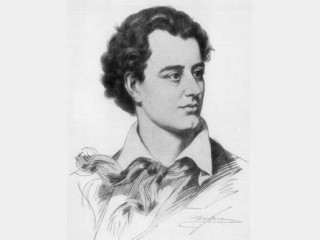
George Gordon, Lord Byron biography
Date of birth : 1788-01-22
Date of death : 1824-04-19
Birthplace : London, England
Nationality : British
Category : Famous Figures
Last modified : 2010-05-20
Credited as : Poet, Leading figure in Romanticism, Don Juan
Known as a romantic poet for his rendition of Don Juan and his travelogue poem called Childe Harold’s Pilgrimage, Lord Byron would become one of Europe’s most captivating artists. His satire mixed with an ironic ego brought freshness to literature that was wholeheartedly accepted.
Born to a Scottish Heiress, Lord Byron’s father squandered away the family’s wealth, which meant that for some time of his childhood he would be brought up in meager conditions. However, at around the age of 10, the young Byron inherited the estates of a great uncle. Bryon went to England’s top school in Newstead. And, at Trinity College, in Cambridge, Byron admitted he had fallen in love with one John Edleston. But, even with his homosexual tendencies, Lord Byron had a greater attraction in his heterosexual undertakings. While there, he also became good friends with John Cam Hobhouse.
Soon after his studies, Byron released his first book of poetry called Hours of Idleness, which did not receive the best reviews. In vengeance, he wrote another satire called English Bards and Scotch Reviewers, which actually won him great recognition. Bryon in 1809 became a member of the House of Lords. With his friend Hobhouse, the two traveled through Portugal, Spain, and onward through Greece. During this voyage, he began one of his most famous works, Childe Harold’s Pilgrimage. Back in London, with the poem’s publication, Lord Byron found himself famous.
Even after his pilgrimage abroad, Lord Byron began to have relationships with his half sister, named Augusta. With Lady Frances Webster, however, he also carried on a relationship. His remorse can be seen in the publication of his next three volumes of poetry, including his most famous, The Corsair. In 1815, Lord Byron married Anne Milbanke and the two conceived a daughter together. The marriage was nothing more than a cover up from Byron’s real sexual interests. However, with greater public pressure about his sexuality and especially about his relationship with his sister, he left England permanently. In Geneva, he settled and wrote another volume of Childe Harold. In Italy, after several more relationships, he wrote the fourth volume to the book of poetry. He then released a poem called Beppo and thereafter began working on his greatest work, Don Juan. Following, Lord Byron became involved with a periodical in The Liberal. By the mid 1820s, Bryon got involved in the politics of Greece and looked for adventure amongst the islands that had brought him his most poignant stories. Thereafter, he passed away after contracting an illness from which he didn’t recover. He would later be recognized as one of England’s most prominent poets.
















